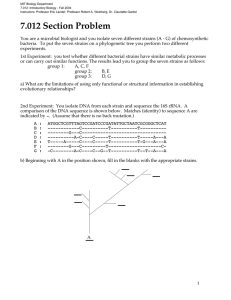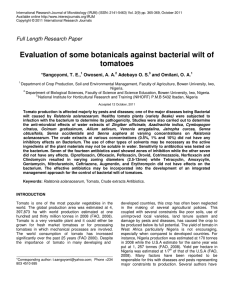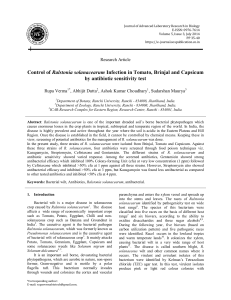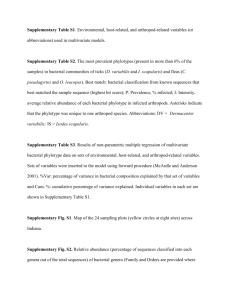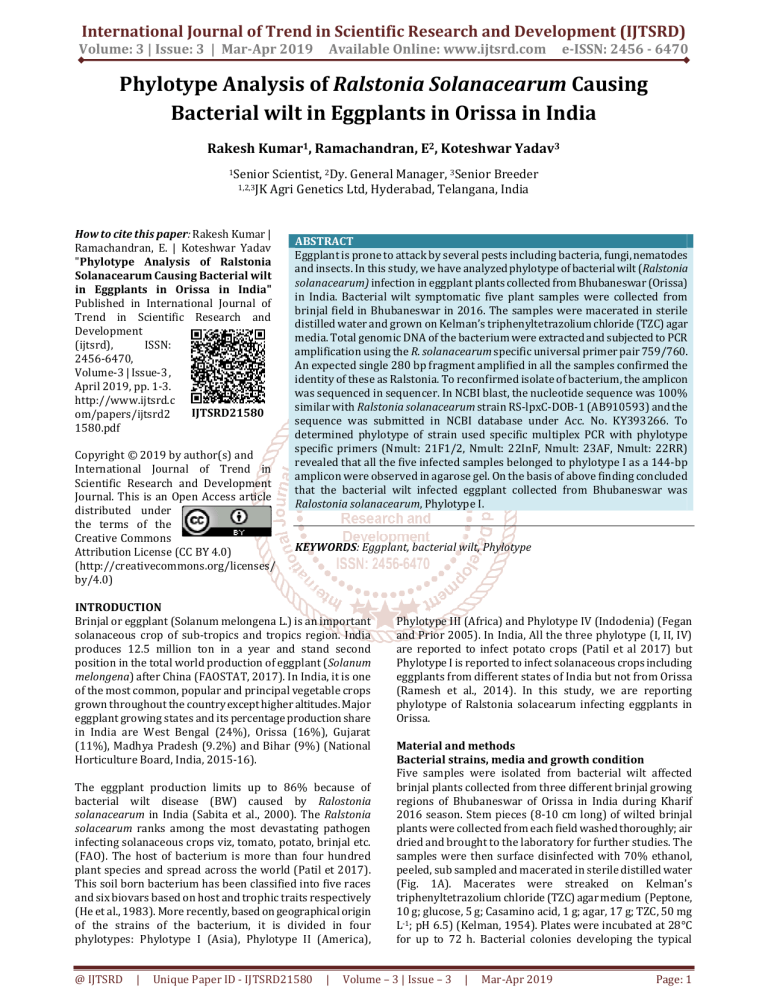
International Journal of Trend in Scientific Research and Development (IJTSRD)
Volume: 3 | Issue: 3 | Mar-Apr 2019
Available Online: www.ijtsrd.com
e-ISSN: 2456 - 6470
Phylotype Analysis of Ralstonia Solanacearum Causing
Bacterial wilt in Eggplants in Orissa in India
Rakesh Kumar1, Ramachandran, E2, Koteshwar Yadav3
1Senior
Scientist, 2Dy. General Manager, 3Senior Breeder
1,2,3JK Agri Genetics Ltd, Hyderabad, Telangana, India
How to cite this paper: Rakesh Kumar |
Ramachandran, E. | Koteshwar Yadav
"Phylotype Analysis of Ralstonia
Solanacearum Causing Bacterial wilt
in Eggplants in Orissa in India"
Published in International Journal of
Trend in Scientific Research and
Development
(ijtsrd),
ISSN:
2456-6470,
Volume-3 | Issue-3 ,
April 2019, pp. 1-3.
http://www.ijtsrd.c
IJTSRD21580
om/papers/ijtsrd2
1580.pdf
Copyright © 2019 by author(s) and
International Journal of Trend in
Scientific Research and Development
Journal. This is an Open Access article
distributed under
the terms of the
Creative Commons
Attribution License (CC BY 4.0)
(http://creativecommons.org/licenses/
by/4.0)
ABSTRACT
Eggplant is prone to attack by several pests including bacteria, fungi, nematodes
and insects. In this study, we have analyzed phylotype of bacterial wilt (Ralstonia
solanacearum) infection in eggplant plants collected from Bhubaneswar (Orissa)
in India. Bacterial wilt symptomatic five plant samples were collected from
brinjal field in Bhubaneswar in 2016. The samples were macerated in sterile
distilled water and grown on Kelman’s triphenyltetrazolium chloride (TZC) agar
media. Total genomic DNA of the bacterium were extracted and subjected to PCR
amplification using the R. solanacearum specific universal primer pair 759/760.
An expected single 280 bp fragment amplified in all the samples confirmed the
identity of these as Ralstonia. To reconfirmed isolate of bacterium, the amplicon
was sequenced in sequencer. In NCBI blast, the nucleotide sequence was 100%
similar with Ralstonia solanacearum strain RS-lpxC-DOB-1 (AB910593) and the
sequence was submitted in NCBI database under Acc. No. KY393266. To
determined phylotype of strain used specific multiplex PCR with phylotype
specific primers (Nmult: 21F1/2, Nmult: 22InF, Nmult: 23AF, Nmult: 22RR)
revealed that all the five infected samples belonged to phylotype I as a 144-bp
amplicon were observed in agarose gel. On the basis of above finding concluded
that the bacterial wilt infected eggplant collected from Bhubaneswar was
Ralostonia solanacearum, Phylotype I.
KEYWORDS: Eggplant, bacterial wilt, Phylotype
INTRODUCTION
Brinjal or eggplant (Solanum melongena L.) is an important
solanaceous crop of sub-tropics and tropics region. India
produces 12.5 million ton in a year and stand second
position in the total world production of eggplant (Solanum
melongena) after China (FAOSTAT, 2017). In India, it is one
of the most common, popular and principal vegetable crops
grown throughout the country except higher altitudes. Major
eggplant growing states and its percentage production share
in India are West Bengal (24%), Orissa (16%), Gujarat
(11%), Madhya Pradesh (9.2%) and Bihar (9%) (National
Horticulture Board, India, 2015-16).
The eggplant production limits up to 86% because of
bacterial wilt disease (BW) caused by Ralostonia
solanacearum in India (Sabita et al., 2000). The Ralstonia
solacearum ranks among the most devastating pathogen
infecting solanaceous crops viz, tomato, potato, brinjal etc.
(FAO). The host of bacterium is more than four hundred
plant species and spread across the world (Patil et 2017).
This soil born bacterium has been classified into five races
and six biovars based on host and trophic traits respectively
(He et al., 1983). More recently, based on geographical origin
of the strains of the bacterium, it is divided in four
phylotypes: Phylotype I (Asia), Phylotype II (America),
@ IJTSRD
|
Unique Paper ID - IJTSRD21580
|
Phylotype III (Africa) and Phylotype IV (Indodenia) (Fegan
and Prior 2005). In India, All the three phylotype (I, II, IV)
are reported to infect potato crops (Patil et al 2017) but
Phylotype I is reported to infect solanaceous crops including
eggplants from different states of India but not from Orissa
(Ramesh et al., 2014). In this study, we are reporting
phylotype of Ralstonia solacearum infecting eggplants in
Orissa.
Material and methods
Bacterial strains, media and growth condition
Five samples were isolated from bacterial wilt affected
brinjal plants collected from three different brinjal growing
regions of Bhubaneswar of Orissa in India during Kharif
2016 season. Stem pieces (8-10 cm long) of wilted brinjal
plants were collected from each field washed thoroughly; air
dried and brought to the laboratory for further studies. The
samples were then surface disinfected with 70% ethanol,
peeled, sub sampled and macerated in sterile distilled water
(Fig. 1A). Macerates were streaked on Kelman’s
triphenyltetrazolium chloride (TZC) agar medium (Peptone,
10 g; glucose, 5 g; Casamino acid, 1 g; agar, 17 g; TZC, 50 mg
L-1; pH 6.5) (Kelman, 1954). Plates were incubated at 28°C
for up to 72 h. Bacterial colonies developing the typical
Volume – 3 | Issue – 3
|
Mar-Apr 2019
Page: 1
International Journal of Trend in Scientific Research and Development (IJTSRD) @ www.ijtsrd.com eISSN: 2456-6470
irregular mucoid colonies were again streaked onto fresh
TZC medium for further purification. Well separated typical
wild type R. solanacerarum colonies were further
transferred to medium modified by exclusion of TZC for
multiplication of inoculums (Fig 1B).
DNA extraction from bacterial strains
The bacterial cultures were grown on nutrient broth and
incubated at 28±1°C with 200 rpm for 48 h. The bacterial
cells were harvested in form of pellet in tube by
centrifugation for 3 min at 13,000 rpm. Supernatant was
discarded and the pellet was resuspended into 300 µl of lysis
buffer (40mM Tris Acetate, 20mM Sodium acetate, 1mM
EDTA, 1% SDS, 0.002% Beta Mercaptoethanol, 1M LAscorbic Acid) by vigorous pipetting and incubated at 37 o C
for 40 min. Afterwards 100 µl of 5M NaCl was added and
mixed thoroughly. Subsequently, 80 µl of CTAB was added,
mixed thoroughly and incubated for 20 min at 65°C.
Chloroform and isoamyl alcohol in the ratio of 24:1 was
added in to the tube, mixed thoroughly and centrifuged for
10 min at 13,000 rpm at 4 oC. 400 µl of clear supernatant was
transferred into new vial and equal volume of chloroform
was added. The tube is mixed vigorously (so that it becomes
milky solution) and centrifuged at 13000 rpm for 10 min.
The aqueous, viscous supernatant was transferred to a fresh
tube (about 300 µl), 0.6 volume isopropanol added and
centrifuged for 10 min at 13,000 rpm to precipitate the
nucleic acids. The supernatant discarded and resulting
pellet washed with 70 per cent ethanol. The pellet was dried
and dissolved in 40 µl of HPLC water.
Phylotype analysis
Phylotype identification of strain was done as described
(Fegan and Prior, 2005; Prior and Fegan, 2005). Phylotype
specific multiplex PCR (Pmx-PCR) was carried out in 20 μl
final volume of reaction mixture, containing 1µl of templete
DNA, 2 µl of 2mM dNTP, 0.5 µM of primers (Nmult: 21: 1F,
Nmult:21:2F, Nmult:22:InF, Nmult:23: AF and 0.5 µM of the
primers 759 and 760 (Opina et al., 1997), 2 µl of 10x PCR
buffer, 1 unit of Taq polymerase and autoclaved double
distilled water to make up the volume 20 µl with following
programme: 96°C for 5 min. followed by 35 cycles of 94°C for
5 sec. 59°C for 30 sec. and synthesis at 72°C for 30 sec. The
final extension allowed for 10 min. at 72°C in thermo cycler
(EPGradientS, Eppendorf) . The PCR product was resolved in
1% agarose gel to analyze the amplification. This Pmx-PCR
amplifies the 280-bp “universal” R. solanacearum specific
reference band plus following phylotype-specific PCR
products: a 144-bp amplicon from phylotype I strains; a 372bp amplicon from phylotype II strains; a 91-bp amplicon
from phylotype III strains; and a 213-bp amplicon from
phylotype IV strains.
Results and discussion
Bacterial strain collection and their identification
In this studies, bacterial wilt infected brinjal stems were
collected in Kharif 2016 season from wilt affected areas of
Bhubaneswar of Orissa state in India. A total of five bacterial
culture were recovered from wilt affected brijal stems. On
Kelman’s (1954) TZC agar medium, these strains yielded
typical virulent type colonies, which were cream coloured,
irregularly shaped, highly fluidal with pink pigmentation in
the centre (Figure 1d). These characters were consistent
with R. solanacearum as described by Kelman (1954) on TZC
agar medium. Total genomic DNA of all the culture was
extracted and subjected to PCR amplification using the R.
@ IJTSRD
|
Unique Paper ID - IJTSRD21580
|
solanacearum specific universal primer pair 759/760. An
expected single 280-bp fragment (Opina et al., 1997)
amplified in all the strains (Fig. 1C), which further confirmed
the identity of these strains as R. solanacearum.
Sequence analysis
One PCR positive samples Out of five samples amplified with
primer pair 759/760 was PCR clean up followed by
sequencing ABI 3130 Genetic Analyzer (Applied Biosystems,
USA). The sequence was blast in NCBI data base and found
100% similarity with Ralostonia solacearum strain RS-lpxCDOB-1 (AB910593) infecting Solanum lycopersicum
(Tomato) in Karnataka and the sequence was submitted in
NCBI data base under Acc. No. KY393266.
Phylotype identification
Phylotype specific multiplex PCR revealed that all the five
strains from Bhubaneswar belonged to phylotype I as a 144bp amplicon was observed in all the strains when Pmx-PCR
products of these strains were subjected to electrophoresis
on 1% agarose gel (Fig. 1D). In multiplex PCR all five samples
were amplified with 280 bp and 144 bp amplification (Fig.
1E) with all five specific primers. The result confirmed that
all the five infected samples were Ralostania solanacearum
Phylotype I only.
As per report Ralostonia solanacerous infecting brinjal in
Bihar, Goa, Maharastra, Kerala, Karnataka, Andman is
Phylotype I but the disease was also reported from Orissa,
Himachal Pradesh and Jharkhand (Chandrashekara et al.,
2012; Dinesh et al., 2010) but phylotype of the disease is
unknown in this area. In this study, the disease infected
samples collected from Bhubaneswar district of Orissa in
India and confirmed the samples were infected with
bacterium by TZC media reaction and the bacterium was
Ralostonia solanacerous by 280 bp amplification with
universal primers 759/760. The bacterial sequence is highly
matching (100%) with reported strain of bacteria infecting
tomato in Karnataka. It was also confirmed that the
unknown bacterium in Orissa belong to Phylotype I by
amplification of 144 bp using specific universal primer and
not belong to Phylotype II, III and IV because it’s not
amplified with specific universal primers in multiples PCR .
On the basis of above finding we can concluded that the
wilted eggplant samples collected from Bhubaneswar
districts of Orissa is Ralostonia solanecerous Phylotype I.
References:
[1] Chandrashekara, K. N., Prasannakumar, M. K., Deepa,
M.,Vani, A. and Khan, A.N.A. 2012. Prevalence of races
and biotypes of Ralstonia solanacearum in India.Journal
of Plant Protection Research, 52(1): 26-31.
[2] Singh D., Sinha S., Yadav D. K., Sharma J.P., Srivastava D.
K., et al. 2010. Characterization of biovar/ races of
Ralstonia solanacearum the incitant of bacterial wilt in
solanaceous crops. Indian Phytopath 63: 261-265
[3] He L.Y., Sequeira L., Kelman A. 1983. Characteristics of
strains of Pseudomonas solanacearum. Plant Dis.
67:1357-1361.
[4] Fegan M., Prior P. 2005. How complex is the “Ralstonia
solanacearum species complex”. In, Bacterial
wiltdisease and the Ralstonia solanacearum species
complex. C Allen, P Prior, AC Hayward (Eds) St. Paul:
APS: 449-462.
Volume – 3 | Issue – 3
|
Mar-Apr 2019
Page: 2
International Journal of Trend in Scientific Research and Development (IJTSRD) @ www.ijtsrd.com eISSN: 2456-6470
[5] Kelman, A. 1954. The relationship of pathogenicity in
Pseudomonas solanacearum to colony appearance on a
tetrazolium medium. Phytopathology 44, 693–695.
[6] Opina, N., Tavner F., Hollway G., Wang J.-F., Li T.-H.,
Maghirang R., Fegan M., Hayward, V. Krishnapillai A. C.,
Hong W. F., Holloway B. W., and Timmis J. 1997. A
novel method for development of species and strainspecific DNA probes and PCR primers for identifying
Burkholderia solanacearum (formerly Pseudomonas
solanacearum). Asia Pac. J. Mol. Biol. Biotechnol. 5:19–
30.
[7] Patil, V. U., Girimalla V., Sagar V. , R. S., Chauhan and
Chakrabarti S. K. 2017. Genome sequencing of four
strains of phytotypes I, II and IV of Ralstonia
solanacearum that cause potato bacterial wilt in India.
Barazil. J. Microbiol., 48, 193-195.
[8] Prior P. and Fegan M.. 2005. Recent development in the
phylogeny
and
classification
of
Ralstonia
solanacearum. Acta Horticult. 695:127-136
[9] Ramesh R., Achari G.A., Gaitonde S. 2014. Genetic
diversity of Ralstonia solanacearum infecting
solanaceous vegetables from India reveals the
existence of unknown or newer sequevars of phylotype
I strains. Eur J Plant Pathol 140:543–562.
[10] Sabita, J. N., Boruah, B. M. and Rachid, H. A., 2000. Yield
potentiality of some brinjal cultivars in severely
bacterial wilt infected condition. Veg. Sci., 27: 76-77.
Figure1. Bacterial wilt of eggplant caused by R. solanacearum showing (A) bacterial streaming in clear water from stem of
infected plant (B) typical R. solanacearum colonies on TZC agar medium and PCR amplification of five infected samples
from Orissa using (C) R. solanacearum specific universal primer pair 759/760 (amplicon: 280bp) (D) Phylotype I specific
primers (E) Phylotype specific multiplex PCR (Lane M = 1 kb ladder, lane 1-5 = strains of R. solanacearum).
@ IJTSRD
|
Unique Paper ID - IJTSRD21580
|
Volume – 3 | Issue – 3
|
Mar-Apr 2019
Page: 3


